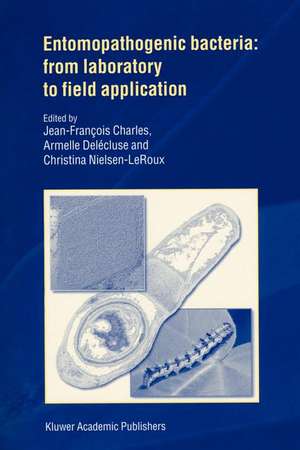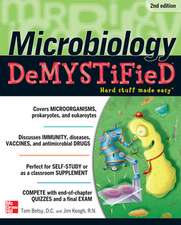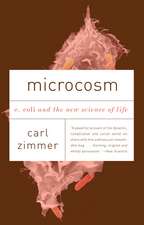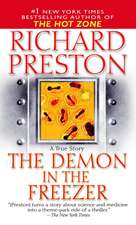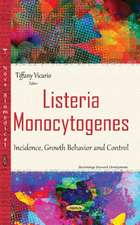Entomopathogenic Bacteria: from Laboratory to Field Application
Editat de J.F. Charles, Armelle Delécluse, C. Nielsen-le Rouxen Limba Engleză Paperback – 9 dec 2010
This new book, the first since 1993 to address all aspects of entomopathogenic bacteria, provides undergraduate and graduate students as well as research scientists with a complete, modern view of this important group of bacteria.
The authors, chosen for their sustained contributions to the field, cover both fundamental and applied research in this area. The main topics include bacterial ecology and taxonomy, toxin diversity, activity and mode of action, regulation and environment of the genes, safety and ecotoxicology, production and field application of the bacteria, and outbreaks of resistant populations. The book concludes with the most recent data obtained on transgenic biotechnology and addresses environmental impact issues.
| Toate formatele și edițiile | Preț | Express |
|---|---|---|
| Paperback (1) | 1228.62 lei 6-8 săpt. | |
| SPRINGER NETHERLANDS – 9 dec 2010 | 1228.62 lei 6-8 săpt. | |
| Hardback (1) | 1235.08 lei 6-8 săpt. | |
| SPRINGER NETHERLANDS – 30 sep 2000 | 1235.08 lei 6-8 săpt. |
Preț: 1228.62 lei
Preț vechi: 1498.31 lei
-18% Nou
Puncte Express: 1843
Preț estimativ în valută:
235.11€ • 242.91$ • 195.58£
235.11€ • 242.91$ • 195.58£
Carte tipărită la comandă
Livrare economică 19 martie-02 aprilie
Preluare comenzi: 021 569.72.76
Specificații
ISBN-13: 9789048155422
ISBN-10: 9048155428
Pagini: 552
Ilustrații: XXII, 524 p.
Dimensiuni: 155 x 235 x 29 mm
Greutate: 0.76 kg
Ediția:Softcover reprint of hardcover 1st ed. 2000
Editura: SPRINGER NETHERLANDS
Colecția Springer
Locul publicării:Dordrecht, Netherlands
ISBN-10: 9048155428
Pagini: 552
Ilustrații: XXII, 524 p.
Dimensiuni: 155 x 235 x 29 mm
Greutate: 0.76 kg
Ediția:Softcover reprint of hardcover 1st ed. 2000
Editura: SPRINGER NETHERLANDS
Colecția Springer
Locul publicării:Dordrecht, Netherlands
Public țintă
ResearchCuprins
Contributors. Preface. Section 1: The Entomopathogenic Bacteria. 1.1. Biodiversity of the entomopathogenic, endosporeforming bacteria; F.G. Priest. 1.2. Natural occurrence and dispersal of Bacillus thuringiensis in the environment; P.H. Damgaard. 1.3. Virulence of Bacillus thuringiensis; B.M. Hansen, S. Salamitou. Section 2: Toxins and Genes. 2.1. The diversity of Bacillus thuringiensis delta-endotoxins; N. Crickmore. 2.2. Insecticidal proteins produced by bacteria pathogenic to agricultural pests; T. Yamamoto, D.H. Dean. 2.3. Vector-active toxins: structure and diversity; A. Delécluse, et al. 2.4. Toxin and virulence gene expression in Bacillus thuringiensis; D. Lereclus, H. Agaisse. 2.5. Genetic and genomic contexts of toxin genes; M.-L. Rosso, et al. Section 3: Mode of Action and Resistance. 3.1. Pathogenesis of Bacillus thuringiensis toxins; P. Lüthy, M.G. Wolfersberger. 3.2. Investigations of Bacillus thuringiensis Cry1 toxin receptor structure and function; S.F. Garczynski, M.J. Adang. 3.3. Membrane permeabilisation by Bacillus thuringiensis toxins: protein insertion and pore formation; J.-L. Schwartz, R. Laprade. 3.4. Insect resistance to Bacillus thuringiensis insecticidal crystal proteins; J. Van Rie, J. Ferré. 3.5. Mode of action of Bacillus sphaericus on mosquito larvae: incidence on resistance; J.-F. Charles, et al. Section 4: Safety and Ecotoxicology.L.A. Lacey, J.P. Siegel. Section 5: Standardisation, Production and Registration. 5.1. Is Bacillus thuringiensis standardisation still possible? O. Skovmand, et al. 5.2. Industrial fermentation and formulation of entomopathogenic bacteria; T.L. Couch. 5.3. Rural production of Bacillus thuringiensis by solid state fermentation; E. Aranda, et al. 5.4. Registration ofbiopesticides; G.N. Libman, S.C. MacIntosh. Section 6: Field Application and Resistance Management. 6.1. Bacillus thuringiensis application in agriculture; A. Navon. 6.2. Application of Bacillus thuringiensis in forestry; K. van Frankenhuyzen. 6.3. Bacterial control of vector-mosquitoes and black flies; N. Becker. 6.4. Resistance management for agricultural pests; R.T. Roush. 6.5. Management of resistance to bacterial vector control; L. Regis, C. Nielsen-LeRoux. Section 7: Biotechnology and Risk Assessment. 7.1. Biotechnological improvement of Bacillus thuringiensis for agricultural control of insect pests: benefits and ecological implications; V. Sanchis. 7.2. Genetic engineering of bacterial insecticides for improved efficacy against medically important Diptera; B. Federici, et al. 7.3. Bacillus thuringiensis: risk assessment; A. Klier. Index.
